![]()
![]()
CILICIAN ARMENIA: EAST MEETS WEST

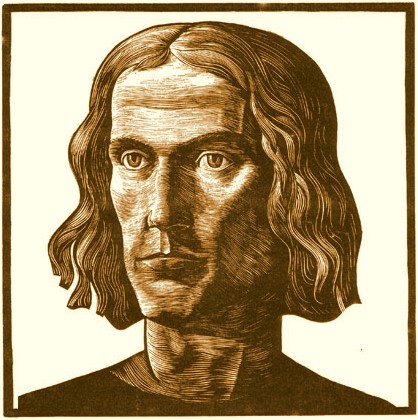
Written by Gevork Nazaryan
The new waves of Armenians to Armenia Minor, Cilician Armenia and neighboring lands further increased the already significant presence. Armenian aristocracy, like the Rubinians and Het'umians were the most prominent representatives of the feudal elite. The Rubinians were direct descendants of the Bagratids, and in 1080, which is incidentally the number of the eternal feminine principle - the Principality of Cilician Armenia was established under their leadership. By 1096, when the First Crusade was initiated, the Principalities of Cilicia and Anatolia had already united in a strong duchy, under the Rubinians.

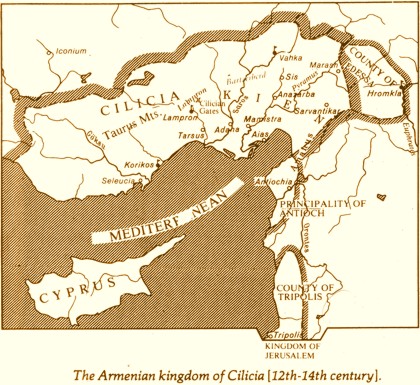
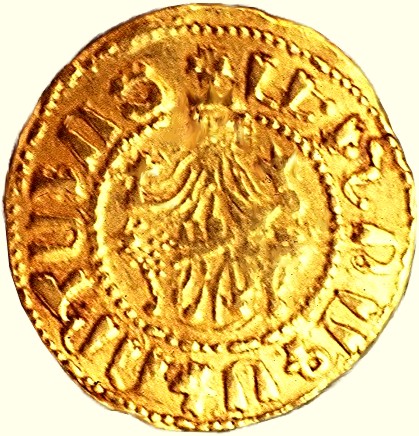
THE GOLDEN COIN OF KING LE[V]ON [LIT. LION]
THE MAGNIFICENT [1187-1219].
THE KING SEATED ON THE LION [FACING EAST AND WEST] THRONE.
ORB [EARTH/TERRESTRIAL/TEMPORALITY] IN HIS RIGHT HAND AND
FLEUR DE-LYS [HEAVEN/CELESTIAL/ETERNITY] SCEPTER IN HIS LEFT HAND.
WRAP AROUND INSCRIPTION -
ȺàÜ Â²¶²ôàð вÚàò
- LEON TAGAWOR HAYOC‘ - LEON
KING OF ARMENIA.
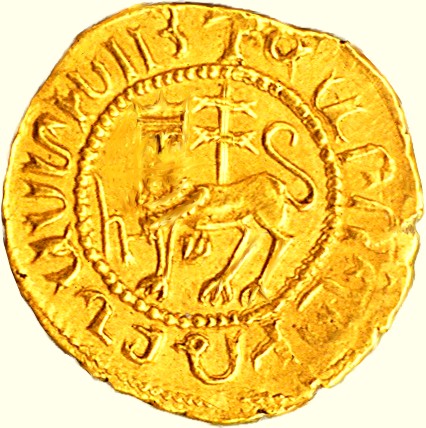
Armenians were among those nations that had contributed greatly to the cause of the Crusades, as later on Pope Gregory XIIIth would state that, ''no nation came more generously to the aid of the Crusaders than the Armenians, who gave them food, men, horses and arms" [Matthew of Edessa]. This is however, not to say that Armenians were not often aligned with local Arab emirs or later on with the Mongol domain, like so many of the Crusader kingdoms would later do against perceived enemies, like the Turks of Konya and the Mamluks. When the Crusaders arrived in Anatolia and Cilician Armenia in 1097 they were welcomed by Prince Constantine of the Rubinian House.
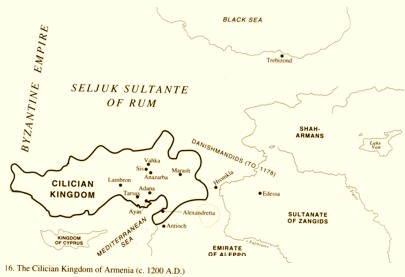
CILICIAN ARMENIA ON THE BEAUTIFUL MEDITERRANEAN COASTLINE. CIRCA
1200 AD
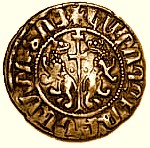
ONE OF TAGAVORAKANS [LIT. ROYAL] STRUCK BY THE ROYAL MINT
AT THE CAPITAL SIS DURING THE REIGN OF LEVON THE MAGNIFICENT [1198/99-1219].
TWIN LIONS FACING THE PATRIARCHAL DOUBLE CROSS [TWO DOTS ON THE SIDES]
WITH THE WRAPPING INSCRIPTION [BETWEEN DOUBLE CIRCLES] BY THE WILL OF GOD
IS HE KING [REVERSE READS: KING LEVON OF ARMENIA].
OBVERSE DEPICTS ENTHRONED KING LEVON [THRONE'S ARMS ARE IN THE
FORM OF TWIN LIONS FACING RIGHT AND LEFT] HOLDING THE ORB [PLANET
EARTH] AND FLEUR-DE-LYS IN HIS RIGHT AND LEFT HANDS RESPECTIVELY.
SPLIT EQUILATERAL MALTESE CROSS AT THE VERY TOP CENTER.
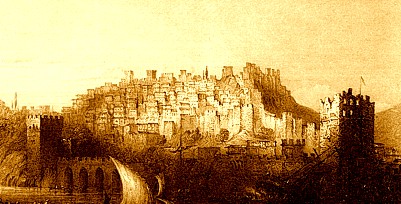
THE GREAT CILICIAN CITY OF ALANYA ON THE BEAUTIFUL SHORES OF
THE MEDITERRANEAN SEA WAS ONE OF MANY FOCAL PORTS OF THE KINGDOM.
Armenians saw in the European newcomers [as naively as so often in the centuries to come, particularly in the nineteenth and twentieth centuries - empty promises of helping to liberate Armenians from the Turkish yoke culminating with the first genocide of the modern era] brothers of a similar religion and allies against the common enemy, the Turks and the Mamluks [the Mamluks were made up of Armenians, Greeks, Slavs and other peoples who were captured and kidnapped and raised as warriors, Mamluk leadership would often consist of converted Armenians -- this practice would later be adopted by the Ottomans for the infamous Janissary corps].
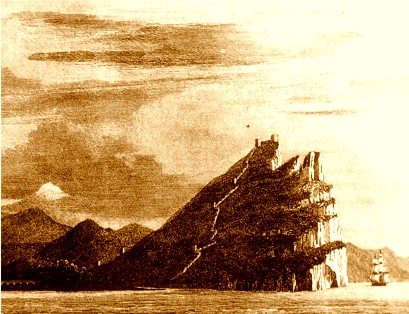
THE WESTERN CILICIAN CASTLE OF S
É L I N O N T E WITH ITS SPECTACULAR VIEW.
For the tired and beleaguered Crusaders who were constantly ambushed throughout their journey [through most of their trip, including the time of stay at Constantinople the Crusaders were disliked and their trip through Anatolia had a devastating effect, many died because of illness, starvation and constant battles against raiding Turks] were unexpectedly amazed at the warm welcome and hospitality of the Armenians. The ruler of Urha (Edessa), T'oros, an old nobleman, and childless ruler wanted an heir to his principality. Ur-Hai the ancient Arman Center was the place where the Crusader knights returned -- the place where according to the ancient account the Light of Christ [Orion] the Liberator was first accepted and defended by Armin King Abgar.
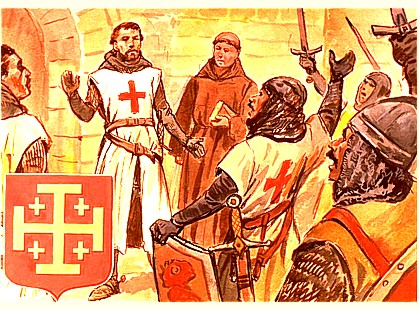
T H E A R M E N I A N K N I G H T S A
N D C R U S A D E R S
He chose one of the leaders of the Crusades, Count Baldwin of Boulogne as an adopted son and a co-ruler (an ill-gotten treaty in which Baldwin became involved in assassination of T'oros initiated by power-hungry Armenian nobles). At the siege of Antioch, Prince Ošin, his brother Bazuni, Constantine Rubinian, as well as the Armenian monks of the Black Mountains and the local
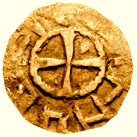
COIN OF PRINCE RUBEN I [1080-1095] FROM BAGRATID NOBILITY
WHO
ESTABLISHED THE SUCCEEDING RUBENID DYNASTY IN CILICIAN ARMENIA.
CROSS PATTÉE WITHIN CIRCLE [MARKED
FOUR POINTS ON QUADRANTS].
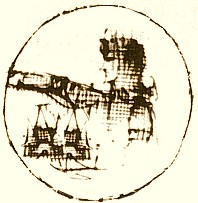
Q U E E N Z A B E L [ISABELLA] UNDERTOOK
NUMEROUS
CONSTRUCTION PROJECTS AND ORDERED THE ERECTION
OF NUMEROUS NEW CHURCHES, CATHEDRALS AND CITIES.
Armenian, populace, all came to the aid of the Crusaders, and the conquest of Antioch, which after long siege could not have been possible without Armenian support. Celebrations of the victory took the form of the marriage of Prince Constantine's daughter to Jocelyn of Courtenay, who inherited the County of Edessa.
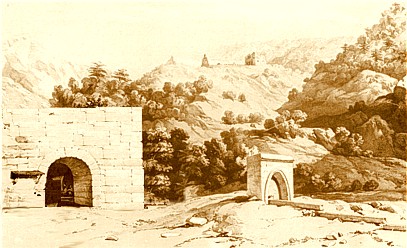
R U I N S O F T H E A L A H A N M O N A S
T E R Y I N T H E FAR BACKGROUND
The daughter of Prince T'oros I, from the Rubinian Royal House, married Count Bauduin, brother of Godfrey. These unions drew Armenians and Franks, as Crusaders were known in the Near East, closer together. Crusader orders such as the Knights Templar [1118], the Knights Hospitallers [also known as the Knights of St. John, recognized by a papal bull in 1113] and the Teutonic Knights [1198] and others were all welcomed and had their branches in Cilician Armenia. It is during this period that the story of the Skull of Sidon [about the mystic power of the Arman bloodline] became renowned throughout Europe.
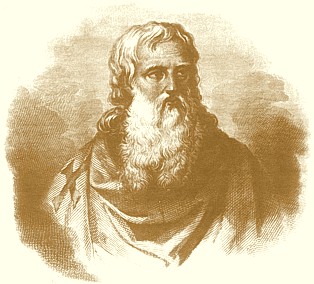
N E R S E S T H E G R A C I O U S
[b. 1100 - d. 1173]. AN OUTSTANDING
PHILOSOPHER, POET, WRITER AND COMPOSER OF COSMIC HYMNS. CANONIZED BY THE
CHURCH FOR HIS DEDICATION TO SEEING THE IMPROVEMENT OF MANKIND
IN ITS UNIVERSAL VALUES AND MORALS.
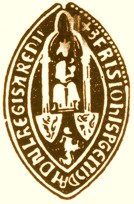
SIGIL OF KING HETUM II [BROTHER IAN]
DEPICTING THE GREAT MOTHER

KING HETUM II IN HIS LATER YEARS BECAME
A FRANCISCAN BROTHER AND IN THE TRUE SPIRIT OF
MONASTIC-MILITARY CHIVALROUS VIRTUE DEDICATED
THE REST OF HIS LIFE IN HELPING THE POOR AND THE DOWNTRODDEN.
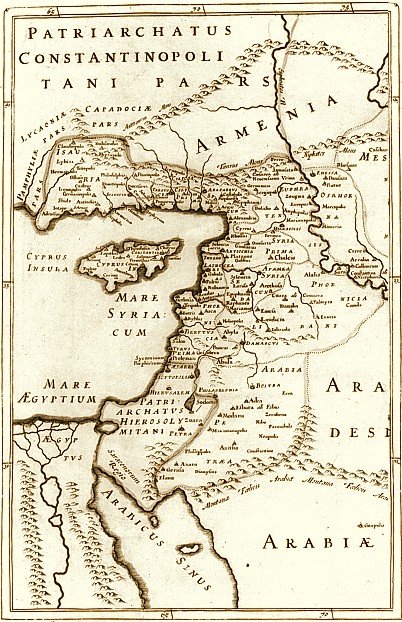
There was already a powerful group of Venetian and Genoese traders in Cilicia around the year 1100. Although the Crusaders were past masters in the manufacture and the handling of siege weapons, in 1112, when unsuccessfully besieging Tyre, they had to summon an Armenian engineer from Antioch to build elaborate siege engines in order to break through.
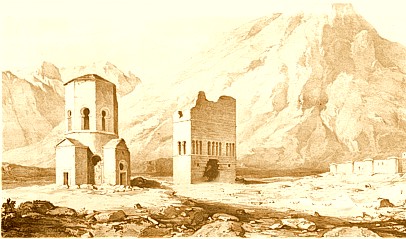
R U I N S
O F A M O
N A S T E R
Y I N B
A R A T A
The walls were breached and Tyre fell to the Crusaders the following year [July 7, 1124]. In 1185 Cilician Prince Levon [honorary Teutonic Knight from the early years of the formation of the Order in 1198] the Magnificent came to power. He distinguished himself as a great leader, as a wise ruler and a warrior king who led the victory against the Turkish troops under sultan Rustam who was killed in the ensuing battle.
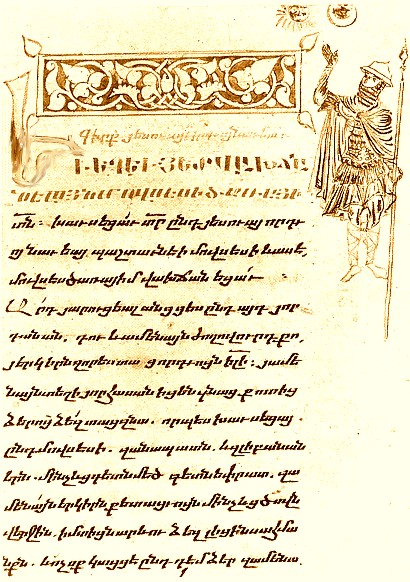
ARMENIAN FOOT SOLDIER FROM A 1270 MANUSCRIPT.
THE SUN AND THE MOON OF DESTINY ABOVE.

PRINCE LEVON -- SON OF KING HETUM -- THE HEIR APPARENT TO THE
CROWN.
REIGNED AS LEVON III [1269-1289] WITH QUEEN KERAN.
NOTE THE BLAZING RED DOT/ORB.
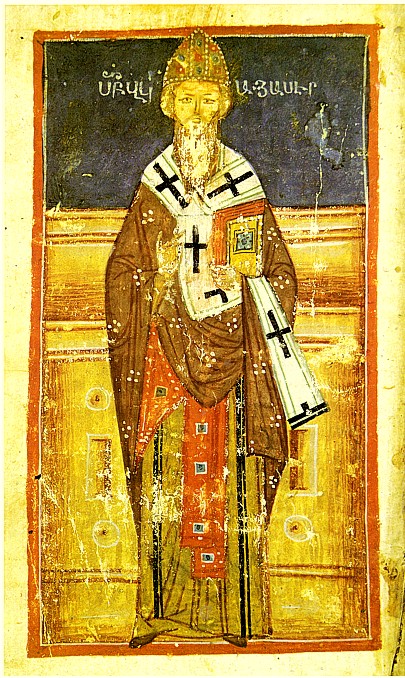
C A T H O L I C O S G R E G O R Y
I I M A R T Y R O P H I L E [1065-1105]
Levon's troops also took part in the siege of Acre, and he was among the lords who assisted Richard I Couer de Lion of England in the conquest of Cyprus (1191) from the Byzantine renegade Isaac Ducas Comneus. Under the enlightened leadership of Levon the Magnificent culture and civilization prospered.

VICTORY OF THE GAMMA KNIGHT. MANUSCRIPT OF ALFONSO X OF
CASTILE.
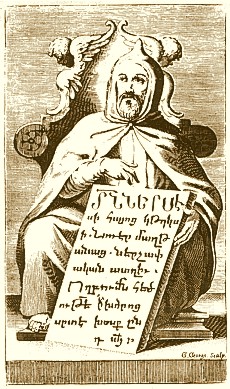
THE BRILLIANT XTH CENTURY MYSTIC PHILOSOPHER WHO
COMPOSED MOVING AND ENLIGHTENING COSMIC HYMNS SUCH AS
THE BOOK OF LAMENT AND RESURRECTION IN PRAISE OF
E U T‛ I W N -- THE DIVINE
ESSENCE AND ONENESS OF ALL.

EXTENDED HAND WITHIN A GOLDEN MEAN RECTANGLE --
CENTERING THE CROSS-AXIS.
PURE GOLD DECORATED WITH PRECIOUS GEMS.
SACRED RELIQUARY FROM ADANA. XIVTH CENTURY.
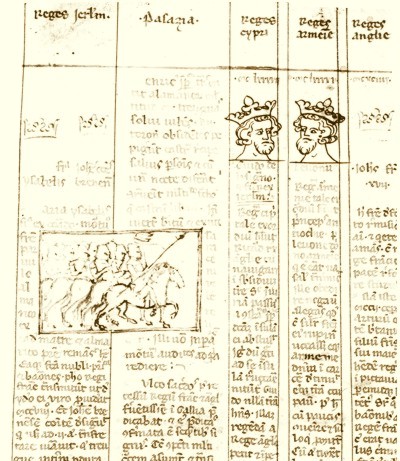
LEVON [LEO[N] -- LION] THE MAGNIFICENT [R] -- GUY DE LUSIGNAN
AND THE ARMENIAN KNIGHTS OF THE CROWN. FROM CHRONOLOGIA MAGNA --
XIVTH CENTURY MANUSCRIPT.
THE LUSIGNAN DYNASTY SUCCEEDED THE HETUMID ROYALS
AFTER THE LATTER EXPIRED OF MALE HEIRS TO THE THRONE.

T H E R
E L I Q U A
R Y O F
S K E V R A
THE GOLD PLATED RELIC IS KEPT IN THE HERMITAGE IN ST. PETERSBURG.
MADE FOR KING HETUM II IN 1293.
THE COSMIC HIERARCHY MOUNTAIN LEADS TO THE ONE CIRCLE
AND THE CRUX OF THE COSMIC SALVATION OF MAN
[RETURN TO GOD THE FATHER].
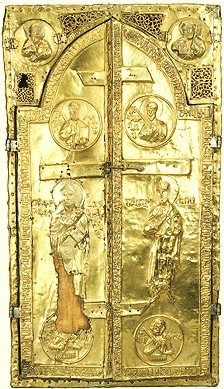
T H E R
E L I Q U A
R Y O F
S K E V R A
CENTRAL PORTION AS A CLOSED GATEWAY --
THE ARCH COMES TOGETHER TO FORM THE WOMB OF COSMOS...
THE PRIMORDIAL ARMANI ![]() SYMBOL OF THE TREE OF LIFE.
SYMBOL OF THE TREE OF LIFE.
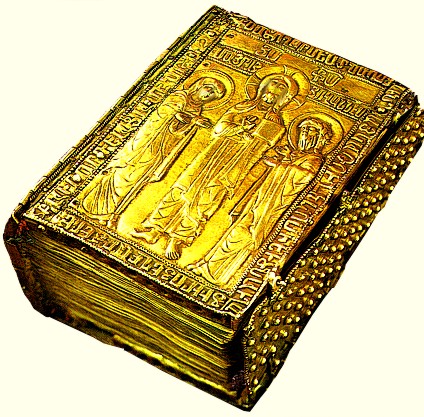
GOSPEL [1255]. GOLDEN COVER WITH FINE EXECUTION OF HIGH ORDER BY
THE
ARMENIAN MASTER GOLDSMITHS.

THE GOSPEL [1270] OF C O N S T A B L E
S M B A T. MATENADARAN MS NO. 7644.
CONSTABLE SMBAT IS ONE OF THE OUTSTANDING FIGURES IN
ARMENIAN HISTORY. BROTHER OF KING HETUM II, SMBAT WAS INSTRUMENTAL
IN FORGING A NUMBER OF MILITARY AND ECONOMIC TREATIES
AND ALLIANCES WITH NUMEROUS COUNTRIES THROUGHOUT THE WORLD.
HE ALSO INTRODUCED A NUMBER OF SOCIO-ECONOMIC AND POLITICAL
REFORMS THROUGHOUT THE NATION, INCLUDING MODIFYING AND REFORMING
THE LAW CODE OF CILICIAN ARMENIA.
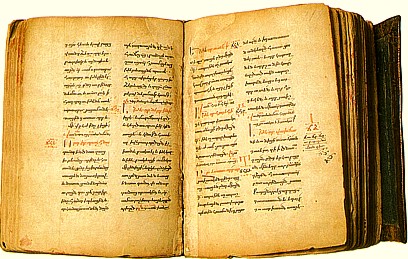
GIRK‘ DATASTANAC‘
[BOOK OF THE LAW -- SURVIVING COPY FROM 1335].
BY MXIT‘AR GOŠ. THIS PARTICULAR COPY MADE BY SCRIBE GRIGOR YEREZ.
JUDICIAL HANDBOOK USED THROUGHOUT CILICIAN COURTS.
MATENADARAN MS NO. 2776
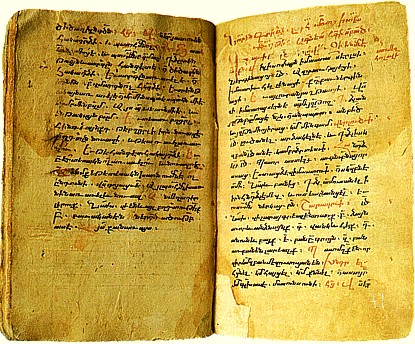
PHILOSOPHICAL WORK FROM 1416. COPIED FROM EARLIER
MANUSCRIPT BY
MONK ANDREAS. MATENADARAN MS NO. 5674.
B E A U T Y.
I D E A L I S M. I
N S P I R A T I O N.
I L L
U M I
N A T
I O N.
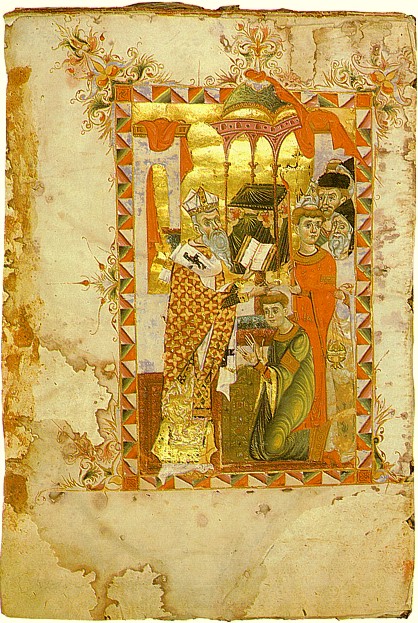
GOLD PLATED ILLUMINATED MANUSCRIPT DEPICTING
ORDINATION INTO THE MONASTIC-KNIGHTLY SPIRITUAL HOLY ORDER.
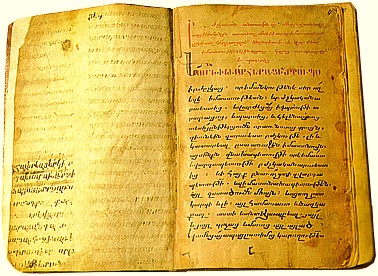
THE GUIDEBOOK [1279] OF MEDICINE BY MEKHITAR HERATSI.
FROM CLOISTER OF SKEVRA. MATENADARAN MS NO. 416.
HERATSI WAS A GREAT DOCTOR WHO IN MANY WAYS
REVOLUTIONIZED THE ART OF MEDICINE BY INTRODUCING
NEW TECHNIQUES OF SURGERIES AND HEALING.
HERATSI WORE THE WHITE ROBE OF THE HEALER BROTHERS.
SPIRITUAL PURITY.

XIIITH CENTURY GOSPEL OF EIGHT ILLUMINISTS. MATENADARAN MS
NO. 7651.P. 75b.
One of the best illuminated manuscripts of the world were made during this period that later would become known as the Silver Age of Armenian Civilization. Most of these hand painted and illustrated holy books are kept in Yerevan's Institute and Depository of Ancient Manuscripts or the Mesrop Mashtots Matenadaran [or The Matenadaran for short] along with other thousands of priceless ancient books -- Armenian as well as from cultures and peoples of the world [texts such as the translations of classical Greek writings were only preserved to our own days thanks to their Armenian translations, originals having been lost in time]. But the main part of the surviving Armenian manuscript collection dates back to the Cilician period.

N E R S E S O F L A M B R O N.
ONE OF THE PROLIFIC WRITERS,
ORATORS AND IMPORTANT SPIRITUAL LEADERS OF THE XIITH CENTURY.
![]()

THE TEMPLE OF PARIS DURING THE TIME OF JEAN-MARC LARMENIUS.
LED BY BERNARD ARMINIACUS [SUCCEEDED BY JEAN ARMINIACUS] WHEN KING
LEVON VI [LEO V, LIT. LION] LUSIGNAN [RELATED TO MEROVINGIANS] WAS IN
EXILE.
This is due to the fact that they have been numerous and have been preserved by the sword of protection by the Kingdom of Cilician Armenia [Aristakēs Lastiverçi, an XIth century historian, tells us only one example of the library at the Monastery of Tat'ev, where around 10,000 books burned in a huge bonfire by the Turks...].

AN EXCERPT FROM LAMBRONAC‛I‛S
PERSONAL MANUSCRIPTS
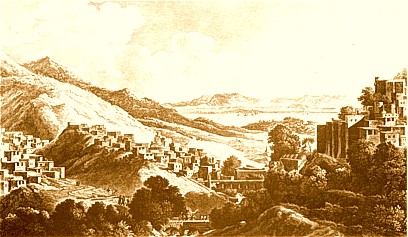
BEYLAN IN PICTURESQUE MEDITERRANEAN HILLS WITH THE BEAUTIFUL
SEASCAPE VISTA OVERLOOKING THE GULF OF ISSOS.
King Levon established a great deal of new educational institutions throughout the Kingdom. New castles and churches were also built by King's orders. It is important to note here that many of the architectural designs in religious and secular buildings, were adopted by the Crusaders who for example successfully applied the forms of round castles instead of the previously square design for construction of strongholds. The traditional conical Armenian domes also were applied in the construction of the emerging gothic form throughout Europe. The Cilician prince was crowned as King Levon I, by the Catholicos of All Armenians, Gregory VIth Apirat, with the blessing of the Archbishop of Mainz, Conrad Vittelbach, on Christmas day, January 6, 1199 [some scholars argue in 1198], in the St. Sophia monastery of the city of Taursus.

ENGRAVING OF L E V O N T H E M A G N I F I C E N T.
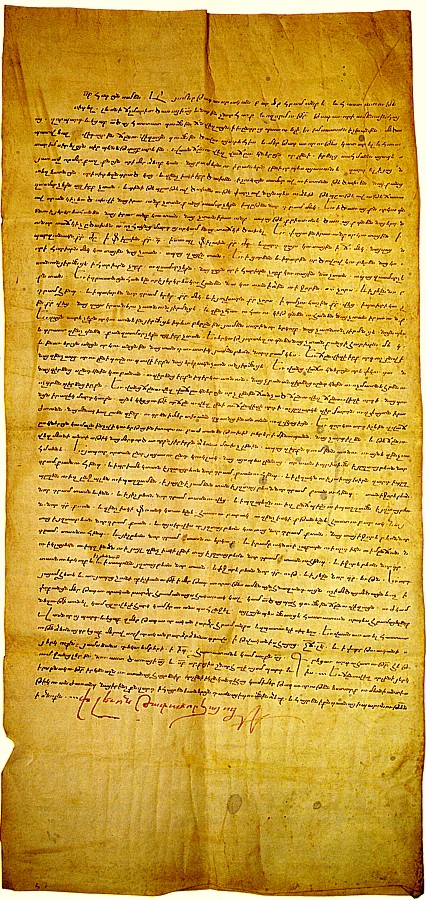
ONE OF THE DECREES [DECEMBER 23, 1288] ISSUED BY LEVON III HETUMID
-- CONNOTING THE GRANTING OF SPECIAL PRIVILEGES AND RIGHTS
TO GENOESE MERCHANT COMMUNITY. KING'S PERSONAL RED SIGNATURE
VERIFYING THE IMPORTANT DOCUMENT
AT THE BOTTOM. DECREED FROM THE CAPITAL SIS.
FROM THE VAULTS OF THE GENOESE MUNICIPAL ARCHIVES.

ANOTHER ONE OF TAGAVORKANS STRUCK BY THE ROYAL MINT
DURING THE REIGN OF LEVON THE MAGNIFICENT.
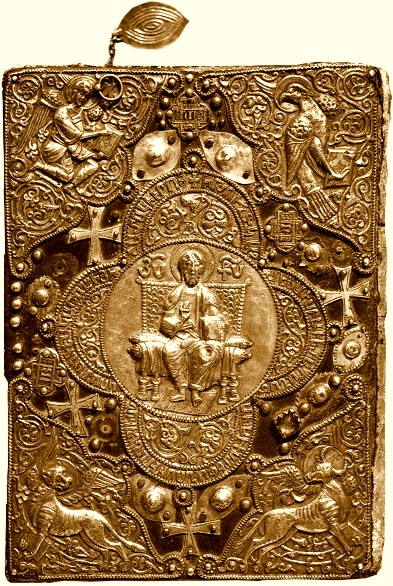
RELIQUARY GOSPEL OF BARDZRBERD. 1254. ONE OF THE MANY
BEAUTIFUL
HOLY RELICS PRESERVED IN THE MUSEUM OF THE CATHOLICOSATE OF
THE GREAT HOUSE OF CILICIA IN ANTELIAS.

Levon was crowned in the presence of guest representatives of the Holy Roman Empire, emissaries from the Papacy and the Byzantine officials, as well as a large contingent of Armenian aristocrats. For his great deeds, the people of Cilicia and the nobility bestowed him the title 'the Magnificent' [Metsagorts]. The Principality of Cilicia became -- the Kingdom of Cilician Armenia or Lesser Armenia as it was referred to by the European historians [sometimes confused with neighboring Armenia Minor]. The Kingdom prospered and fought against almost constant foreign invasions for nearly 200 years. The Kingdom of Cilician Armenia fell to the Mamluks, who previously successfully overran the Crusader states of Jerusalem and Antioch and had turned their attention to the remaining obstacle in their conquest of the Near East.

THE ST. DENIS CATHEDRAL IN THE SUBURBS OF PARIS. THE
HONORARY PANTHEON
OF EUROPEAN ROYALTY. THE FINAL RESTING PLACE OF KING LEVON VI LUSIGNAN
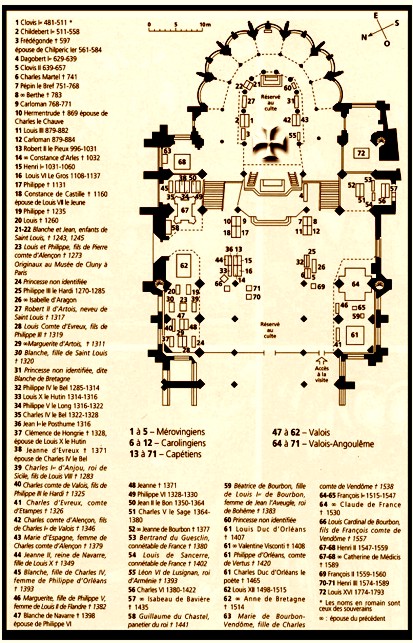
THE LEGEND OF THE SAINT DENISE BASILICA. THE FLOOR PLAN
AND THE POSITIONING OF ALL OF THE EFFIGIES AND TOMBS OF THE 72 KINGS AND
QUEENS
[MEROVINGIAN BLOOD OUT OF WHOM SPRANG THE CAROLINGIANS AND
CAPETIANS] INTERNED IN THE HOLY SANCTUM. LÉON
[LION] VI DE LUSIGNAN
ROI D'ARMÉNIE [NO.55] IN THE TOP
CENTER OF THE INNER SANCTUM [CROSS].

THE SACRED EFFIGY SHRINE OF DAGOBERT I [NO. 4 IN THE ABOVE
MAP LEGEND OF THE HOLY BASILICA] IMMEDIATELY
BELOW [RIGHT STEPS] THE EFFIGY OF LEVON VI.

LICHFIELD CATHEDRAL IN STAFFORDSHIRE [1195-1330]
WITH COMPLETED THREE SPIRES [INSTEAD OF USUAL TWO].
AS IT LOOKED DURING THE HUNDREDS YEARS WAR
WHEN LEVON VI [LEO V] PAID A VISIT TO HIS COUSIN
KING RICHARD II IN LONDON.
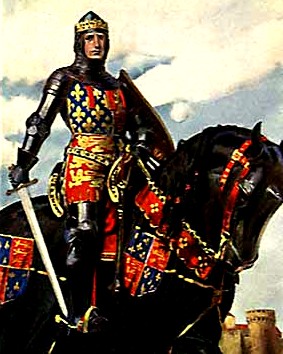
THE BLACK PRINCE -- EDWARD PRINCE OF WALES
[1330 - 76] -- FATHER OF RICHARD II [1377-99].
RED-BLUE-GOLD/ORANGE FLEUR-DE-LYS AND LION
SAME HERALDIC COLORS AND SYMBOLISM OF LAST
LUSIGNANS [AZURE-SILVER -- COLORS
OF THE LUSIGNAN HOUSE]
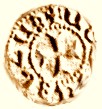
REVERSE SIDE OF ONE OF THE COINS STRUCK DURING THE REIGN OF
LEVON VI WITH THE EIGHT-POINT [ENLIGHTENMENT MANDALA]
SPLIT [FISH TAIL...EA] EQUILATERAL CROSS. THE OBVERSE SHOWS
THE ARMENIAN LION [LEVON/LEO].
THE WRAP AROUND INSCRIPTION OF THE KING IS WITHIN THE TWO
CIRCLES THAT ARE ARRANGED IN DOTS...OTHER COINS
DEPICTED EQUILATERAL CROSSES IN THE FORM OF 4
UNITED TAUS...ALSO MARKED WITH FOUR RAYS EMANATING FROM
THE CROSS [AGAIN 8] WHILE THE OBVERSE SHOWS THE CROWN HEAD OF THE KING.

In 1373, Levon VI (1373-75) succeeded Constantine IV (1365-75) and was destined
to be the last king of Cilician Armenia. In 1374, under general Malik al-Sharif
Sha’ban, the Mamluks launched a massive attack on exhausted Cilician Armenia. On
April 13,
1375 -- after nine months of courageous last ditch defense in the
fortress of Kapan by the Armenian knigths, the Mamluks broke through and the
Capital Sis fell. King Levon
and Queen Marguerite along with the royal family and many members of the
aristocracy were taken prisoner to Cairo -- the Mamluk capital. After more than
seven years in Egyptian captivity, on October 7, 1382, King Levon and members of
the royal family were finally freed after a substantial ransom paid by the
Spanish kings of Aragon and Castile.
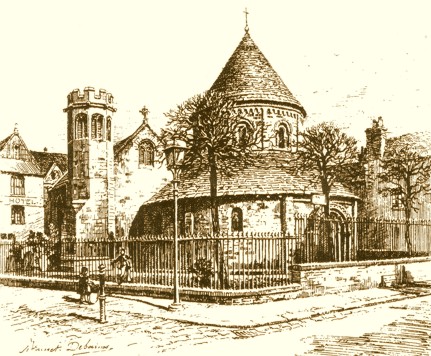
THE ROUND CHURCH [THE CHURCH OF THE HOLY SEPULCHER] IN CAMBRIDGE.
BUILT BY THE CRUSADER ARCHITECTS BASED ON ARMENIAN PATTERN
AFTER THEIR RETURN FROM CILICIAN ARMENIA.
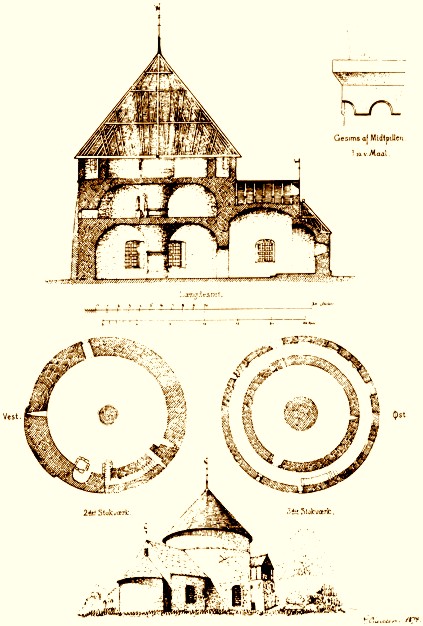
THE NYLARS CHURCH CONSTRUCTED BY THE KNIGHTS OF THE RED CROSS
Levon journeyed from Cairo through Spain to France, to the court of Charles VI “where he was welcomed as a friend.” King Levon of Armenia, being a cousin of both Charles VI of France and King Richard II of England ['nostre cousyn le roy d’Armenye'], began the mediation of peace between two warring states engulfed in a series of bitter wars that in historiography later became known as the Hundred Years War. However, “the fire of mutual hatred was too intense to be extinguished so quickly.”
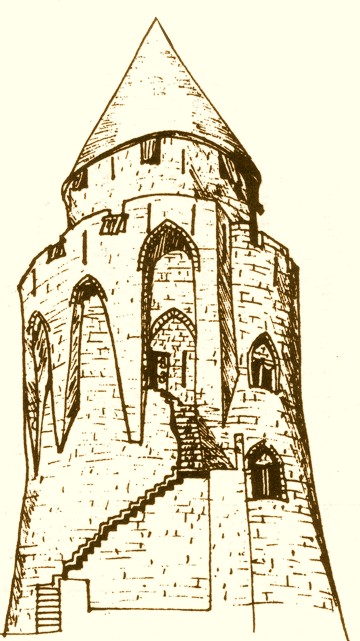
AN IMPREGNABLE CASTLE OF AN ARMENIAN LORD BUILT ON A HIGH CLIFF
WITH AN EXTENSIVE VIEW SPAN. THE ARMENIAN MASTER BUILDERS WERE
GENIUS ARCHITECTS. MANY OF THE CASTLE BUILDING TECHNIQUES WERE COPIED
AND SUCCESSFULLY APPLIED THROUGHOUT EUROPE AFTER THE CRUSADES.
THE FOUR PRINCIPAL CORNERSTONES
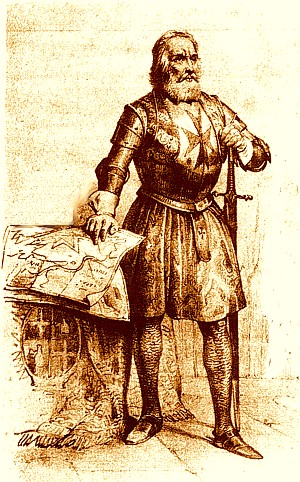
HONOR. JUSTICE. COURAGE. SACRIFICE.
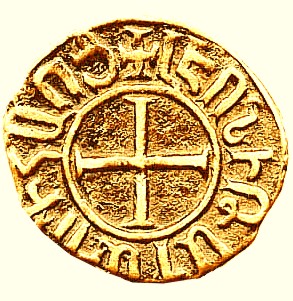
ONE OF THE GOLD COINS STRUCK BY LEVON III.
ARMENIAN TAGAVORAKANS WERE THE PREFERRED CHOICE OF
CURRENCY ON INTERNATIONAL MARKETS EVEN SURPASSING
THE VALUE OF VENETIAN DUCATS.

THE KNIGHT'S OF ST. JOHN OF JERUSALEM DEFEND THE KINGDOM
OF ARMENIA. HISTORIC PAINTING BY HENRI DELABORDE [1844].
KING CONSTANTINE III LUSIGNAN WITH THE LOYAL BODYGUARD OF
LEADINGS KNIGHTS HOSPITALLERS IN THE GOLDEN PORT OF A Y A S.

MINTED COIN OF KING HETUM II. ENCIRCLED
CROSS PATTÉE [1289-1296 & 1299-1301].
Levon was immensely disappointed after his entreaty to King Richard II and the English Parliament at Westminster to end “fighting the French instead leading a new Christian crusade to recover Cilician Armenia” did not come to pass. King Levon, the last monarch of the Kingdom of Cilician Armenia, “disappointed in his labors and expectations” passed away in Paris, on November 29, 1393. His remains were interred in the sacred Célestins Monastery [where today the Caserne de Célestins stands on Henri IV avenue in Paris] and during the upheaval of the French Revolution were moved to the safety of the sacred basilica of St. Denis, the resting place of many of the European royals, on the outskirts of the French capital. The actual remains of the King Levon IV as with so many French royals are interred in the Parisian catacombs that are underneath the City of Lights.

URBAT‛GIRK [BOOK OF
FRIDAY]. FIRST ARMENIAN PUBLISHED BOOK
VENICE 1512. THE ARMENIAN TIES WITH THE ITALIAN CITY-STATES
WERE GREATLY ACCELERATED DURING THE CILICIAN PERIOD AND
EXTENDED WELL BEYOND THE FALL OF CILICIAN ARMENIA
TO FOREIGN INVADERS. CULMINATING WITH THE ESTABLISHMENT OF
THE MEKHIATARIST BROTHERHOOD IN EARLY XVIIITH CENTURY
BY ABBOT MEKHITAR AND THE BLOSSOMING OF THE LEARNING CENTER
INTO A WORLD RENOWNED ARMENIAN ACADEMY OF SCIENCES
[STATUS GRANTED BY EMPEROR NAPOLEON BONAPARTE]
ON THE ISLAND OF SAN LAZARO, VENICE.

A RECONSTRUCTION BY KENNETH JOHN CONANT OF THE MONASTERY AND
ABBEY
AT CLUNY. THE COMPLEX WAS BUILT BASED ON THE TRADITIONAL
ARCHITECTURAL PATTERN OF THE ARMENIAN MASTER BUILDERS.


THE CASTLE OF LUSIGNAN. THREE TOWERS ARE ALIGNED TO FORM
POINTS OF A TRIANGLE. LEADING TO THE CENTRAL HALL.
THE ANCESTRAL CASTLE OF THE LUSIGNANS THE SCIONS OF
THE GREAT MOTHER MÉLUSINE THAT GAVE
BIRTH TO MOST OF THE ROYAL
HOUSES OF EUROPE, CYPRUS, JERUSALEM AND THE LAST DYNASTY OF
THE KINGDOM OF ARMENIA.
THE LINEAGE CONTINUES THROUGH THE HOUSE OF SAVOY.

ANCESTRAL LANDS IN ANJOU, POITOU, BERRY, ORLÉANS,
LIMOUSIN AND BOURBON.
THE COAT-OF-ARMS OF THE HOUSE OF LUSIGNAN IS
VERTICALLY STANDING RED LION UPON A SHIELD OF
FIVE WHITE AND FIVE BLUE INTERCHANGEABLE HORIZONTAL
STRIPES.

REDEMPTION THROUGH LOVE AND GRACE.
The renowned XIXth century Mekhitarist Father Łewond Alishan, in his monumental work on Cilician Armenia -- Sisuan, quoting a contemporary Jerusalem chronicler of the Middle Ages, states that “an army of one hundred thousand Muslims moved on [the capital] Sis, (p. 392).” Although this figure is probably somewhat exaggerated, it nevertheless is indicative of the Mamluk forces in the offensive against Cilicia.

Another historian of Cilician Armenia, Armen Ghazarian noted: “Levon’s heroic pleas to both the French and the English came to naught. His first task of bringing the two warring nations to the peace table was never achieved. This was the necessary precondition for the success of his ultimate plan because whilst France and England remained at war with each other, it was virtually certain that they would turn a deaf ear to his message.
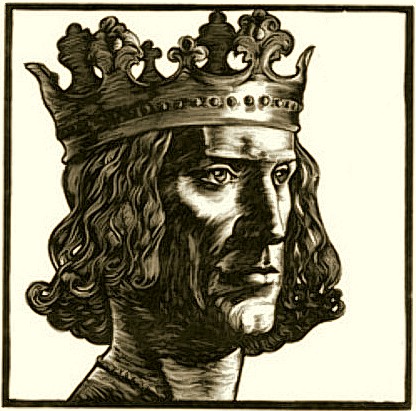
L E V O N V I L U S I G N A
N. THE LAST CILICIAN KING WHO
DEDICATED HIS LIFE UNTIL THE VERY END OF HIS DAYS TO
SEEING THE L I B E R A T I
O N O F A R M
E N I A
FROM FOREIGN YOKE.

When Levon was in Paris he befriended Philippe Mézirès, an ardent and staunch supporter of the idea of crusade against the infidels. It was Philippe who pressured Richard of England and the dukes of York and Gloucester into admitting that aiding the fragmented Christian East must surely be their solemn duty. Instead of the English fighting the French, their objectives would be best served by the restoration of the kingdoms of Cilician Armenia and Jerusalem. Philippe must have had an impressive influence on Levon if for no
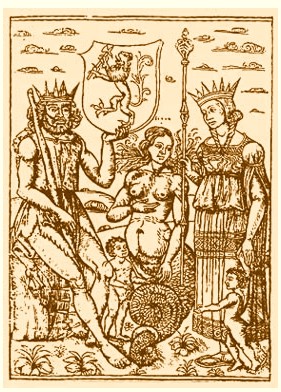
M É L U
S I N E. THE DIVINE SERPENTINE AQUATIC GREAT MOTHER.
DIVINE BIRTH GIVER AND PATRONESS OF THE LUSIGNAN BLOODLINE.
[TSOVINAR...AYA...WHO FROM THE PRIMORDIAL WATERS GAVE BIRTH TO
THE TWINS AS DEPICTED IN THE ENGRAVING]. THE KING IN HIS LEFT ARM
HOLDS THE SHIELD DEPICTING THE LION [LEON] HOLDING THE AXE OF
POWER. THE LUSIGNAN QUEEN HOLDS IN HER RIGHT ARM THE STAFF OF DIVINITY.
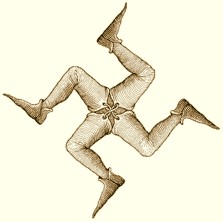
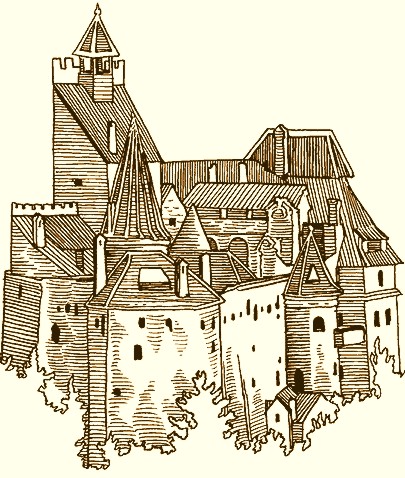
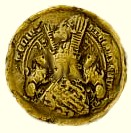
SEAL OF THE LAST KING OF THE LUSIGNAN BLOODLINE.

BEAUTIFUL XIXTH CENTURY ENGRAVING [PRIVATE COLLECTION, PARIS]
OF THE EFFIGY OF THE LAST ARMENIAN KING... LEVON VI LUSIGNAN [1340-1393]
IN THE SACRED ST. DENIS BASILICA....A HOLY SHRINE OF PILGRIMAGE FOR THE
AUTHOR OF THESE WORDS...
other reason than that the two had shared a common dream, a dream which as late as the 14th century had not yet entirely faded from the psyche of the descendants of those who fought the early crusades.”
